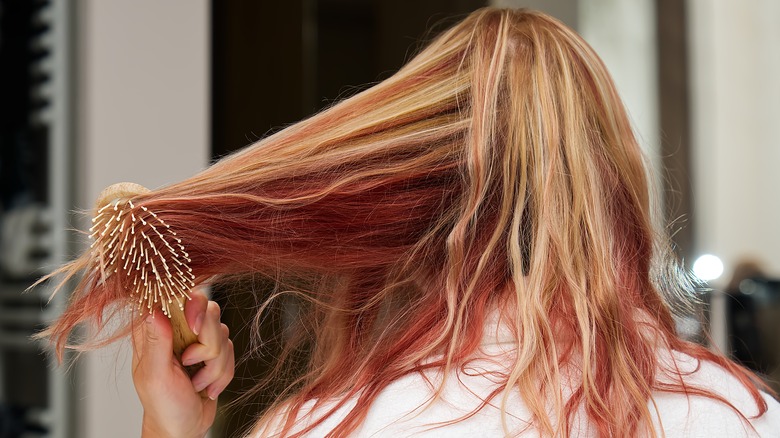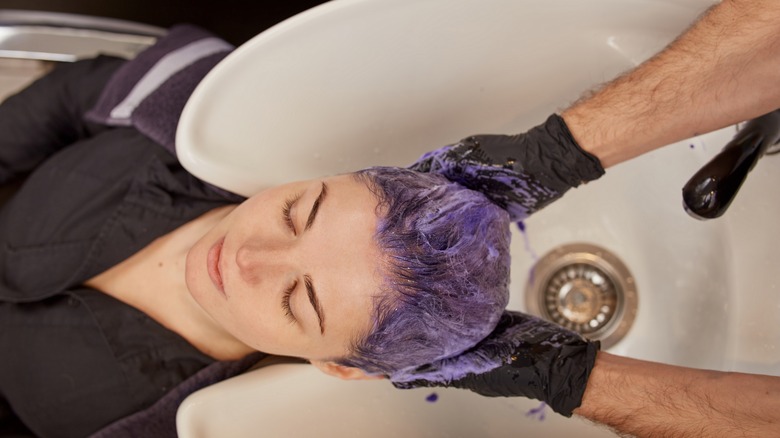Here's Why Your Hair Color Is Washing Out Way Too Fast
Dying your hair takes a lot of courage. So much thought goes into the choice because it can create such a stark difference in your overall look and vibe. You need to pick the perfect hair color that looks great on you while still being noticeably different. You have to decide if you want to get it done in a salon or risk coloring your hair at home. You'll probably spend hours educating yourself on different dyes to find the one that causes the least damage.
After devoting so much time and effort to the process, you take the first look in the mirror. Chances are you're not the biggest fan five minutes in, but slowly, it begins to grow on you. A few days post-coloring, you begin to fall in love with it. But alas! Just as it becomes your new normal, you realize the color is fading away, and the process begins all over again.
You might think that your hair color has run its natural course, and that could be the case. Generally, your hair color should last six to eight weeks, but that number can vary. It depends on the permanence of the hair dye, your personal hair growth, the color, and if you're using bleach to prolong its life. Regardless, your hair dye shouldn't fade away well before its time. If you find that happening, you might be doing a couple of things wrong.
Avoid these mistakes with colored hair
One of the easiest mistakes to make with dyed hair is overwashing. As a general rule of thumb, you shouldn't wash colored hair more than four times a week. Try to space out your hair washing as much as possible and only use haircare products that are specially formulated for dyed hair because they seal the color in. If you want to keep your hair fresh between washes, simply spray on some dry shampoo.
Another common mistake is exposing your hair to too much heat. As colorist Aaron Brandford explained to Real Simple: "In the presence of heat, the scales of the cuticle expand like a pinecone. When this happens, color molecules are able to fall out." Some common ways you could be doing this include taking long, hot showers and using styling tools like flat irons. Since, obviously, you need to shower regularly, you should know how to take one that works in your best interests.
CHI stylist Shawnee Heltsley shared her recommended shower routine with Women's Health: "I always tell my clients to shampoo and rinse with room-temp water, towel dry, condition, then rinse with the coldest water you can stand to seal that cuticle shut." For extra caution, you can also get a shower filter that keeps your water mineral and chemical-free to protect your hair from further damage and color loss.
It's vital to keep dyed hair well-nourished
Another reason for your hair color washing out prematurely is sun exposure. Speaking to Real Simple, Kristen Fleming, color director at Chicago's 3rd Coast Salon, shared: "The sun's UVA and UVB rays break down the chemical bonds in hair color dyes, causing [the] color to fade and even bleaching out natural hair tones." To protect your hair, don a hat when stepping out or use products that offer UV protection.
Likewise, to keep dyed hair looking shiny and nourished, and extend its life further, you can also use a hair gloss treatment. This is a more pocket-friendly alternative that can help you space out the time between your color appointments, and you can even do it yourself in the comfort of your own home. If you want to ensure your hair color lasts longer, first and foremost you need to show your locks a whole lot of love.
Damaged hair can cause hair color to stick improperly and wash away a lot quicker due to its uneven surface. To fix this problem, you need to nourish your hair with hydrating hair masks, deep condition once a week, and use naturally-rejuvenating hair oil treatments. Some replenishing ingredients to look out for include jojoba, olive, and coconut oil. Crucially, even if you do find your hair color fading away sooner than you'd like, you shouldn't get a touch-up done any earlier than six weeks post-treatment to curb further damage.


